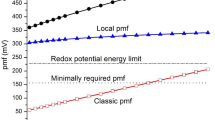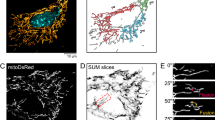Abstract
THE electrical properties of the membrane of giant mitochondria (4–10 μm in diameter) can be studied directly with micro-electrodes. Tupper and Tedeschi1–4 have studied mitochondria isolated from Drosophila (approximately 4 μm in diameter), and found a positive potential in the range of 5–15 mV and a specific resistance in the range of 1–4 Ω cm2 (assuming no invaginations of the mitochondrial membrane). The potentials were not found to depend on metabolic state2. The microelectrodes were judged to be in the internal mitochondrial space from the fact that the potentials were osmotically sensitive (decreasing with osmotic swelling in a predictable manner). The positive potentials correlated with the distribution of carboxylic anions, which partition with a higher concentration inside the mitochondria. Furthermore, the potentials were collapsed by the addition of acetate3,4, but not chloride4 to the external medium. Presumably acetate enters and depolarises the potential. These observations further support the idea that the electrodes are in the inner mitochondrial space.
This is a preview of subscription content, access via your institution
Access options
Subscribe to this journal
Receive 51 print issues and online access
$199.00 per year
only $3.90 per issue
Buy this article
- Purchase on Springer Link
- Instant access to full article PDF
Prices may be subject to local taxes which are calculated during checkout
Similar content being viewed by others
References
Tupper, J. T. & Tedeschi, H. Proc. natn. Acad. Sci. U.S.A. 63, 370–377 (1969).
Tupper, J. T. & Tedeschi, H. Proc. natn. Acad. Sci. U.S.A. 63, 713–717 (1969).
Tupper, J. T. & Tedeschi, H. Science 166, 1539–1540 (1969).
Tedeschi, H. in Energy Transduction in Respiration and Photosynthesis (eds Quagliariello, E., Papa, S. & Rossi, C. S.) 767–779 (Adriatica Editrice, Bari, 1971).
Maloff, B. L., Scordilis, S. P. & Tedeschi, H. Science 195, 898–900 (1975).
Maloff, B. L., Scordilis, S. P. & Tedeschi, H. J. Cell Biol. 78, 199–213 (1978).
Maloff, B. L., Scordilis, S. P. & Tedeschi, H. J. Cell Biol. 78, 214–226 (1978).
Maloff, B. L., Scordilis, S. P. & Tedeschi, H. Science 199, 568–569 (1978).
Suchy, J. & Cooper, C. Expl cell. Res. 88, 198–202 (1974).
Wakabayashi, T., Asano, M. & Kurono, C. Acta path. Jap. 25, 39–49 (1975).
Bowman, C., Maloff, B. L. & Tedeschi, H. in Frontiers of Biological Energetics 1 (eds Dutton, P. L., Leigh, J. & Scarpa, A.) 413–421 (Academic, New York, 1978).
Tyler, A., Monroy, A., Kao, C. Y. & Grundfest, H. Biol. Bull. 111, 153–177 (1956).
Loewenstein, W. R. & Kanno, Y. J. Cell Biol. 22, 565–586 (1964).
Loewenstein, W. R. & Kanno, Y. J. gen. Physiol. 46, 1123–1140 (1963).
Author information
Authors and Affiliations
Rights and permissions
About this article
Cite this article
BOWMAN, C., TEDESCHI, H. Electrical properties of giant mitochondria studied with a double impalement technique. Nature 280, 597–599 (1979). https://doi.org/10.1038/280597a0
Received:
Accepted:
Published:
Issue Date:
DOI: https://doi.org/10.1038/280597a0
Comments
By submitting a comment you agree to abide by our Terms and Community Guidelines. If you find something abusive or that does not comply with our terms or guidelines please flag it as inappropriate.



